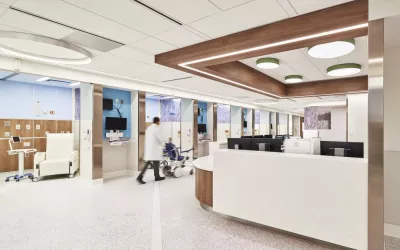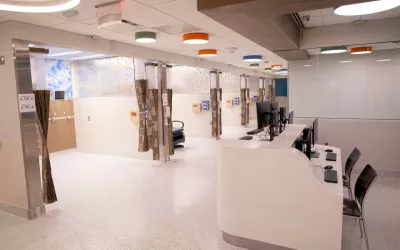Newly Designed Children’s Emergency Department Opens at The Mount Sinai Hospital
The Mount Sinai Hospital has announced the completion of a full renovation of its children’s emergency department (ED), and a newly redesigned area for walk-in, low-acuity adult patients. These are the first two phases of a five phase redesign project that will double the footprint of the entire ED. The project is slated for final completion in 2024.
Part of the hospital’s $70 million transformation was made possible by donations from Andrew and Denise Saul, as well as Aerin Lauder Zinterhofer and Rolex Watch U.S.A. The facility features innovative, state-of-the-art assessment and treatment rooms to enhance access to life-saving, high-quality care and an improved experience for the 100,000 patients who visit the ED each year.
“We have used input from patients and staff alike to design a new emergency department and to build an approach that is centered both on delivering high-quality care and on making the experience of receiving care at Mount Sinai patient-centered,” said Brendan G. Carr, MD, MS, chair of emergency medicine for the Mount Sinai Health System. “We are excited that this investment has created opportunities for us to advance emergency care in ways that significantly enhance our commitment to learn, grow, and elevate our ability to meet the acute care needs of our community.”
The new Mount Sinai Children’s Emergency Department at The Mount Sinai Hospital is tailored to the needs of children and their families, with a separate space from the adult ED and is connected to all services within Mount Sinai Kravis Children's Hospital. It is nearly double the size of the previous space and has increased bed capacity. The design elements used throughout the environment, including colorful lighting and an interactive video feature wall, provide a calming atmosphere to put the youngest and most vulnerable patients at ease and help them feel comfortable.
The location also houses a newly established special “resuscitation space” for critical care cases to enhance treatment for the sickest children and a low-stimulation room — a quieter and calmer area for children with autism or other sensory challenges — which is unique among New York-area emergency departments.
“We are excited to offer a more comfortable experience for pediatric patients,” said Christopher Strother, MD, director of pediatric emergency medicine at The Mount Sinai Hospital. “This new space allows us to treat and care for low-acuity patients more quickly and effectively, as well as provide advanced care for critically ill and injured patients. The modern and functional design will allow our pediatric patients to get exceptional care when they are feeling their worst.”
"The opening of our new children’s emergency department is the first of many exciting changes planned to ensure that we continue to provide the best and most compassionate care to children in our region,” explains Fernando Ferrer, MD, FACS, FAAP, chief operating officer of Mount Sinai Kravis Children’s Hospital. “This innovative facility, dedicated solely to children, will allow our talented teams of pediatric emergency medicine professionals and child life specialists to provide care in an environment designed to comfort both patients and their families. As our emergency department is often a starting point in a child's health journey at Mount Sinai, our new facilities will ensure a best-in-class care experience.”
This adult section of the Saul Family Emergency Department has an expanded space for triage and treatment, as well as new protocols for expedited care. As soon as patients get registered at the front desk, staff will assess their condition and take them back to the triage area to limit their time in the waiting room. Within minutes, a doctor or physician assistant will assess patients, gather medical history, and then immediately order any lab work or X-rays. The newly designed space allows for better workflow, enabling rapid diagnosis and treatment.
“The Mount Sinai Hospital is taking an important step in streamlining the process of patient care in the Emergency Department,” explains David Reich, MD, president and chief operating officer of The Mount Sinai Hospital. “It is designed to expedite the start of patient care, and move patients more quickly through the system to the point of hospital discharge. We expect to see improved outcomes as a result of these efforts, but this redesign and the clinical care principles we have put in place are just the beginning of our journey to transform emergency care at Mount Sinai, and we are excited for the continued evolution of these key facility upgrades.”
The emergency department of the Mount Sinai Health System has more than 200 faculty members in seven hospitals across the New York metropolitan region. The next phases of renovations are the geriatric emergency department, main emergency room, critical care area, and observation area.
The Mount Sinai Health System is New York City's largest academic medical system, encompassing eight hospitals, a leading medical school, and a vast network of ambulatory practices throughout the greater New York region. The Health System includes approximately 7,300 primary and specialty care physicians; 13 free-standing joint-venture centers; more than 410 ambulatory practices throughout the five boroughs of New York City, Westchester, and Long Island; and more than 30 affiliated community health centers.












